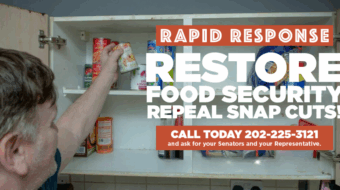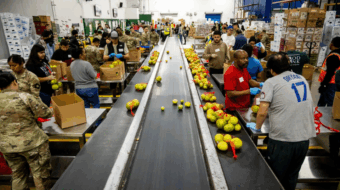
Would you like some antibiotic-resistant bacteria with your grilled chicken at your backyard barbeque? Of course not. But that likelihood continues to grow unless the government makes industry change the way most American farm animals are raised.
American industrial animal production has fed our farm animals a steady diet of antibiotics for decades. Now, the bacteria are fighting back and we’re all paying the price.
An estimated 70 percent of all antibiotics (about 24.6 million pounds a year) consumed in this country are used non-therapeutically to help promote growth in our pigs, chickens, and cattle in overcrowded pens known as “confined animal feeding operations” (CAFOs). Without antibiotics added to their feed, disease would rapidly infect these animals.
In these factory farms, bacteria are exposed to low levels of antibiotics for long periods of time. That provides ideal conditions for the creation of bacterial resistance. Many of the antibiotics used to raise factory-farmed animals are the same prescription drugs that doctors use to treat sick humans. Now, antibiotic resistance developed in CAFOs is becoming a public health problem for us all.
The medical community has taken strong steps to reduce the over-prescription of antibiotics to humans to slow the development of these superbugs. But we can’t win this battle without a similar effort by meat and poultry companies.
Antibiotic resistance is already proving costly–at least $4 to $5 billion a year in health costs alone, according to an estimate from The National Academy of Sciences. With few new antibiotics on the horizon, protecting what we have is essential.
After dragging its feet for years, the government has finally taken the first timid steps to address this crisis. The Food and Drug Administration published in June a draft of new guidelines for the meat and poultry industry. The agency outlined a set of principles calling for the use of antibiotics to be limited to treating animal disease and to include veterinary oversight. FDA officials said these voluntary guidelines laid the groundwork for possible future regulations. Unfortunately, the agency sets no timeline for future regulations, which could be years, even decades, in the making.
To protect America’s health, Congress must accelerate action to protect antibiotics. More than 80 of the nation’s public health organizations, including the American Medical Association and the American Public Health Association, have endorsed a bill that would halt of the overuse of antibiotics in raising food animals. The bill, introduced by the only microbiologist in Congress, Rep. Louise Slaughter (D-NY), would phase out the non-therapeutic use of seven classes of antibiotics in animals–unless the FDA determines the drugs do not contribute to antibiotic resistance affecting humans. The modest bill would still allow farmers to treat sick animals and it only covers antibiotics also used to treat humans.
But the big drug and meat companies represent a powerful lobby in Washington, and have thus far blocked the bill and FDA action. Why are they expending such effort to prevent this major public health initiative? As usual, it has to do with the bottom line. Banning antibiotics for healthy animals raised in extremely crowded conditions would mean that chicken, cattle, and pigs would require more room. The cost of producing beef, pork, and chicken would likely rise–although it would be nothing compared to the health costs linked to antibiotic-resistant bacteria.
The good news is that it doesn’t have to be this way. We can raise enough animals for food and still protect the effectiveness of antibiotics. Denmark, the world’s largest pork exporter, banned antibiotic feed additives in 1998. Producers improved animal husbandry and hygiene, and the overall use of antibiotics in agriculture dropped by over 50 percent. A similar ban is now in place in the rest of Europe. And of course many American farmers in the U.S. already use these more sustainable practices, producing pork, chicken and livestock without antibiotics.
Nearly all of us have needed antibiotics at some point in our lives. If we want antibiotics to work for us and our children in the future, we have to get smarter about how we use them. We need to find the political will to act.
Ben Lilliston is communications director at the Institute for Agriculture and Trade Policy and the co-author of the book “Genetically Engineered Foods: A Self-Defense Guide for Consumers.” This article was distributed by Other Words, a project of the Institute for Policy Studies.
Photo: http://www.flickr.com/photos/spcummings/3116867309/ cc 2.0









